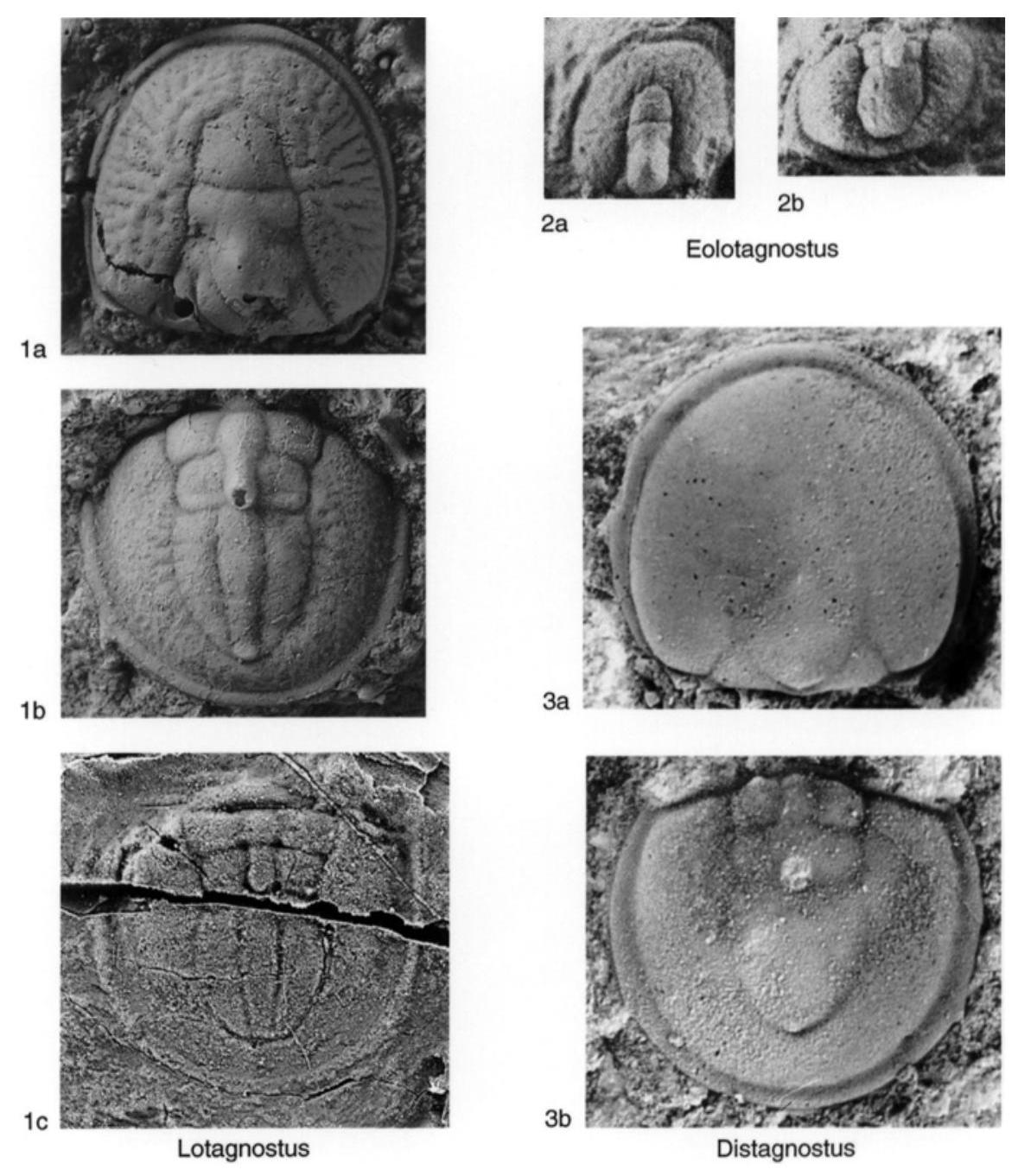Welcome to the Treatise on Invertebrate Paleontology!
Please enter a genera name to retrieve more information.

Lotagnostus
Classification
Phylum:
Arthropoda
Class:
Trilobita
Order:
Agnostida
Superfamily:
Agnostoidea
Family:
Agnostidae
Formal Genus Name and Reference:
Lotagnostus WHITEHOUSE, 1936, p. 101
Type Species:
*Agnostus trisectus Salter, 1864b, p. 10, holotype by monotypy (SALTER, 1864b, pl. 1, fig. 11), BGS 8768, London
Images
(Click to enlarge in a new window)
Fig. 218, 1a,b. * L. (L.) trisectus (Salter) sensu WestergArd, 1922, Upper Cambrian (Peltura minor Zone), Sweden (Andrarum, Skåne), a, cephalon, SGU 127, X 7.2, b, pygidium, SGU 128, X .2 (new).——Fig. 218,1c. * L. (L.) trisectus (Salter), Upper Cambrian (Merioneth Series, Peltura scarabaeoides Zone), northern Wales (Dolgellau), plastoholotype, pygidium, wax impression, BGS 8768, X8 (new).
Synonyms
Geographic Distribution
Argentina, England, Wales, Sweden, Canada (Nova Scotia, Quebec), Peltura Zone, (Newfoundland), Sunwaptan, China (Xinjiang, Zhejiang, Hunan, Anhui, Guizhou), Kazakhstan, USA (Vermont, Maryland)
Age Range
Beginning Stage in Treatise Usage:
Upper Cambrian
Beginning International Stage:
Guzhangian
Fraction Up In Beginning Stage:
50
Beginning Date:
498.75
Ending Stage in Treatise Usage:
Upper Cambrian
Ending International Stage:
Cambrian Stage 10
Fraction Up In Ending Stage:
100
Ending Date:
486.85
Description
Variably effaced, with usually nondeliquiate border furrows and unconstricted acrolobes, with or without a median preglabellar furrow. F3 furrow straight or bent backward, posterior lobe with well-developed F2 furrows, glabellar node located from midway between F1 and F2 furrows to level with F2 furrow. Basal lobes large, triangular, in some species incorporating the narrow (tr.) portions of the M2 lobe. Pygidium bispinose, axis long (sag.), M1 trilobate, F1 impressed at least laterally, M2 trilobate, F2 always impressed. Posterior lobe elongate, semiovate to ogival, with well-developed terminal node.
References
Museum or Author Information
Classification
Phylum:
Arthropoda
Class:
Trilobita
Order:
Agnostida
Superfamily:
Agnostoidea
Family:
Agnostidae
Formal Genus Name and Reference:
Lotagnostus WHITEHOUSE, 1936, p. 101
Type Species:
*Agnostus trisectus Salter, 1864b, p. 10, holotype by monotypy (SALTER, 1864b, pl. 1, fig. 11), BGS 8768, London
Images
(Click to enlarge in a new window)
Fig. 218, 1a,b. * L. (L.) trisectus (Salter) sensu WestergArd, 1922, Upper Cambrian (Peltura minor Zone), Sweden (Andrarum, Skåne), a, cephalon, SGU 127, X 7.2, b, pygidium, SGU 128, X .2 (new).——Fig. 218,1c. * L. (L.) trisectus (Salter), Upper Cambrian (Merioneth Series, Peltura scarabaeoides Zone), northern Wales (Dolgellau), plastoholotype, pygidium, wax impression, BGS 8768, X8 (new).
Synonyms
Geographic Distribution
Argentina, England, Wales, Sweden, Canada (Nova Scotia, Quebec), Peltura Zone, (Newfoundland), Sunwaptan, China (Xinjiang, Zhejiang, Hunan, Anhui, Guizhou), Kazakhstan, USA (Vermont, Maryland)
Age Range
Beginning Stage in Treatise Usage:
Upper Cambrian
Beginning International Stage:
Guzhangian
Fraction Up In Beginning Stage:
50
Beginning Date:
498.75
Ending Stage in Treatise Usage:
Upper Cambrian
Ending International Stage:
Cambrian Stage 10
Fraction Up In Ending Stage:
100
Ending Date:
486.85
Description
Variably effaced, with usually nondeliquiate border furrows and unconstricted acrolobes, with or without a median preglabellar furrow. F3 furrow straight or bent backward, posterior lobe with well-developed F2 furrows, glabellar node located from midway between F1 and F2 furrows to level with F2 furrow. Basal lobes large, triangular, in some species incorporating the narrow (tr.) portions of the M2 lobe. Pygidium bispinose, axis long (sag.), M1 trilobate, F1 impressed at least laterally, M2 trilobate, F2 always impressed. Posterior lobe elongate, semiovate to ogival, with well-developed terminal node.
